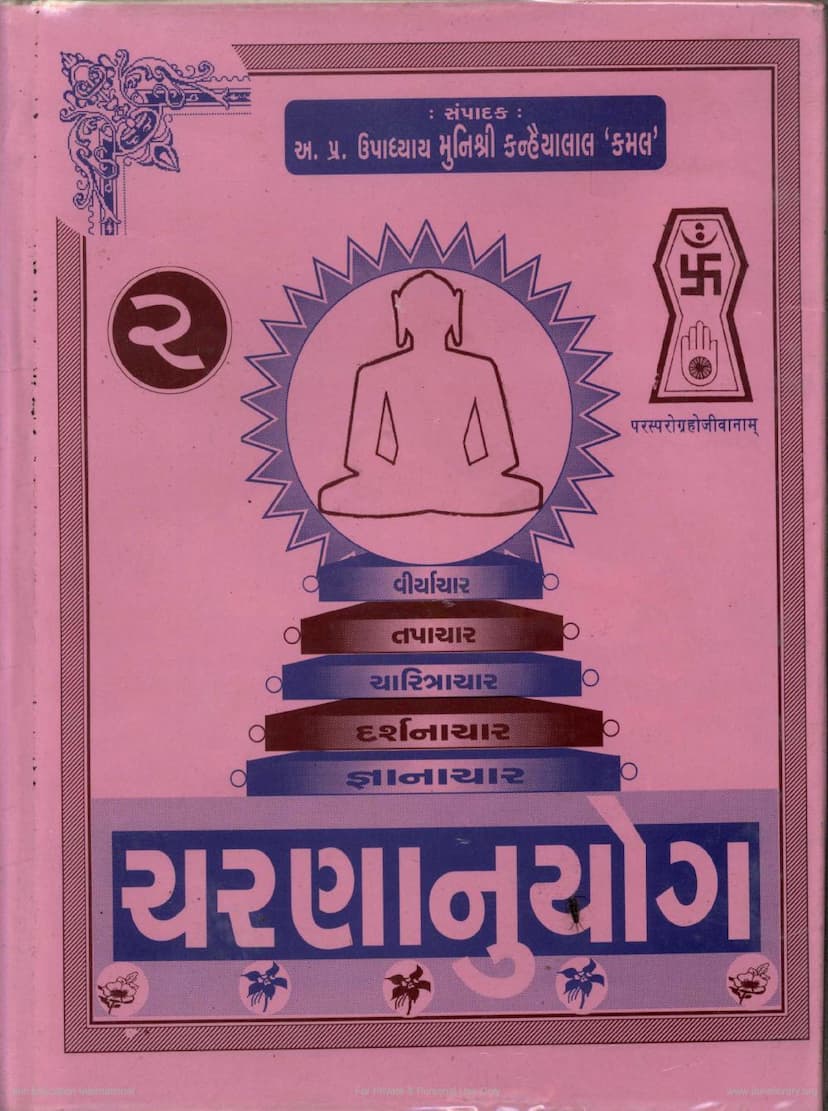Charnanuyoga Part 2
Added to library: September 1, 2025

Summary
Here's a comprehensive summary of the provided Jain text, "Charanānuyoga Part 2" by Kanhaiyalal Maharaj, based on the text you shared:
Book Title: Charanānuyoga Part 2 Author: Kanhaiyalal Maharaj Publisher: Āgam Anuyog Prakashan
This document is the second volume of the Charanānuyoga series, focusing on the principles of conduct (Āchār Dharma) as described in the Jain Āgamas. It translates and compiles the relevant material from the original Āgamas into Gujarati.
Overall Scope:
The book delves into the profound philosophical and practical aspects of Jain conduct, meticulously organized into different "Anuyogas" or analytical divisions of Jain scriptures. Part 2 of Charanānuyoga, in particular, appears to focus on the detailed rules and principles governing the life of ascetics and lay followers, with a significant emphasis on ethical discipline, self-control, and spiritual practice. The extensive table of contents reveals a systematic approach to understanding various facets of Jain way of life, including:
Key Themes and Content:
-
The Foundation of Āchār (Conduct): The text emphasizes the paramount importance of "Āchār" (conduct) in Jainism, stating "Āchāraḥ prathamo dharmaḥ" (Conduct is the first religion), which aligns with the Āchārāṅga Sūtra being the first Anga of the Jain canon. It highlights that "Charaṇa" (character/conduct) is the core of spiritual discipline.
-
The Four Anuyogas: The book is structured within the framework of the four Anuyogas (analytical divisions of Jain scripture):
- Charanānuyoga: Deals with conduct and ethics.
- Dharma-kathānuyoga: Focuses on edifying stories and examples.
- Gaṇitānuyoga: Concerns mathematics, astronomy, and geography.
- Dravyānuyoga: Explains the nature of substances and their classifications.
-
The Significance of Charanānuyoga (Part 2): This volume focuses on the second part of Charanānuyoga, building upon the first part which has already been published. It aims to provide a thorough compilation of the ethical content from the Āgamas.
-
Detailed Breakdown of Conduct (Āchār): The book elaborates on the five fundamental divisions of Āchār:
- Jñānāchār (Conduct of Knowledge): Discusses the proper acquisition and application of knowledge, including concepts like Kālachāra (time-bound conduct), Vinaya (respectful conduct), and Bahumānāchāra (conduct of showing reverence).
- Darshanāchār (Conduct of Perception/Faith): Explores the right attitude, faith, and understanding towards Jain principles and Tirthankaras, including discussions on Samyaktva (right faith) and its various aspects.
- Charitrāchār (Conduct of Character/Action): This appears to be a major focus, detailing the strict rules and practices for ascetics, including the five Mahāvratas (great vows), Samitis (caution in actions), and Guptis (restraint).
- Tapāchār (Conduct of Austerity): Covers the principles and practices of various types of austerities (internal and external) undertaken for spiritual purification and karmic shedding.
- Viryāchār (Conduct of Vigour/Effort): Emphasizes the necessary spiritual strength, effort, and perseverance required in the spiritual path.
-
The Role of Scholars and Monks/Nuns: The preface and acknowledgments highlight the collaborative effort involved in compiling and translating this complex text. It credits Upadhyaya Muni Shri Kanhaiyalalji 'Kamal' as the chief editor and provides insights into the roles of Mahasati Shri Muktiprabhaji, Mahasati Shri Divyaprabhaji, Mahasati Shri Anupamaji, and others in the translation and compilation, showcasing the deep scholarship and dedication within the monastic community. Pandit Shri Dalsukhbhai Malvania's role as a special advisor is also noted.
-
Emphasis on Practical Application: The text consistently links theoretical knowledge with practical application in daily life, especially for the monastic community. It discusses how to cultivate virtues like non-violence (Ahimsa), truthfulness, non-stealing, chastity, and non-possession (Aparigraha) through specific conduct and practices.
-
Detailed Discussions on Specific Concepts: The table of contents reveals detailed discussions on:
- Discipline and Restraint: Emphasizing the control of senses, mind, speech, and body.
- The Four Kinds of Vows (Vrata): Likely detailing Mahavratas (for ascetics) and Anuvratas (for lay followers).
- Samitis and Guptis: The fivefold caution in conduct and the threefold restraint.
- Austerities (Tapas): Internal and external forms of austerity for spiritual growth.
- Rules of Conduct: Specific guidelines for ascetics regarding begging (Ächār), dwelling (Vihar), speech (Bhasha), and daily routines.
- Penances and Expiations (Prayashchitta): Detailed discussion on offenses and their corresponding expiations, highlighting the meticulous nature of Jain ethical codes.
- The Role of the Guru and Disciple: Emphasizing the importance of the Guru-Shishya relationship and the ethical conduct within it.
- The Concept of Ānuyoga and its Practicality: Discussing how these analytical divisions help in understanding the vastness of Jain literature and its practical application.
-
Memorial and Dedication: The book is dedicated to the memory of the author's parents and is published in memory of Gurudeva Fateh-Pratap. This indicates a deep respect for lineage and spiritual heritage.
In essence, "Charanānuyoga Part 2" by Kanhaiyalal Maharaj is a detailed and scholarly work that serves as a comprehensive guide to Jain ethical conduct and monastic discipline. It systematically breaks down the principles of right action and character as prescribed in the Jain tradition, drawing heavily from the foundational Āgamas and making them accessible through translation and compilation.